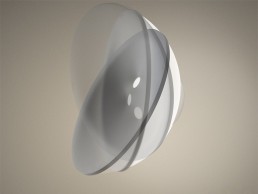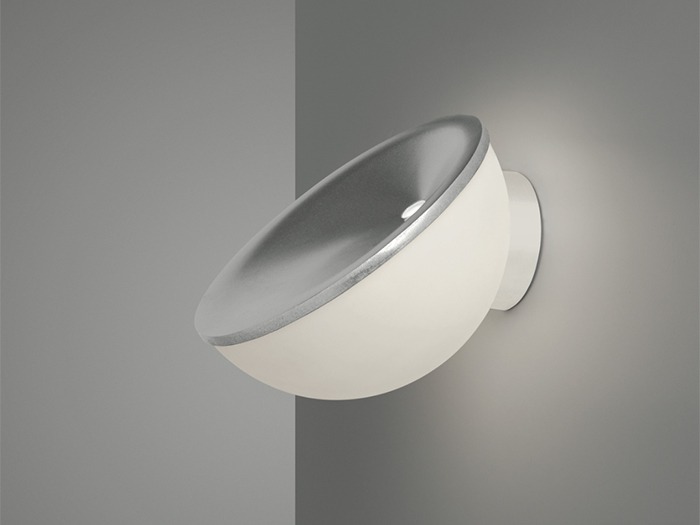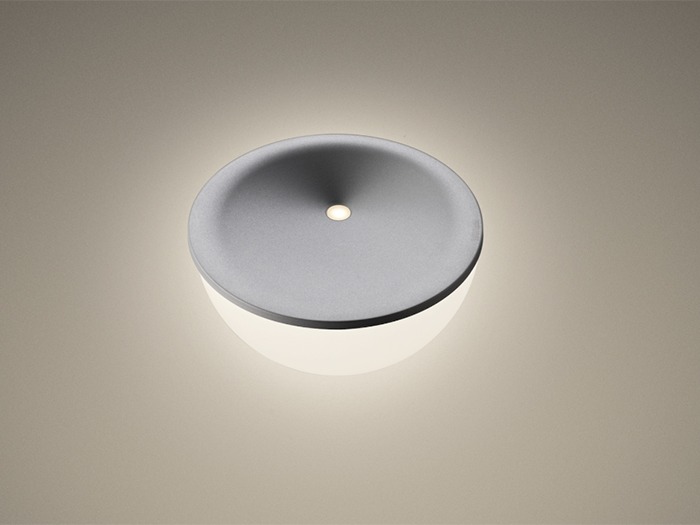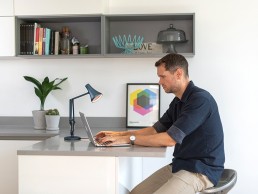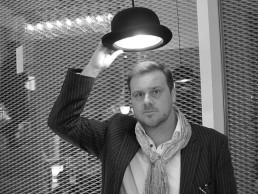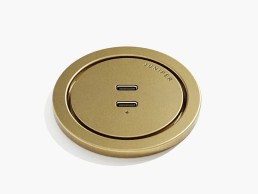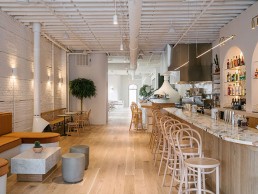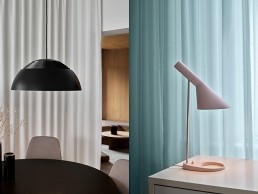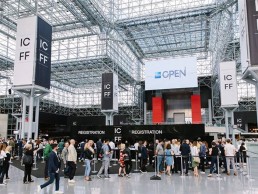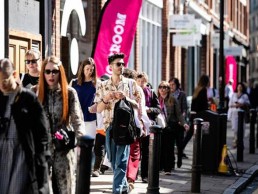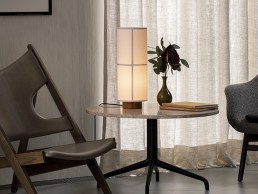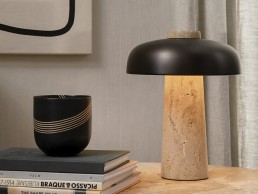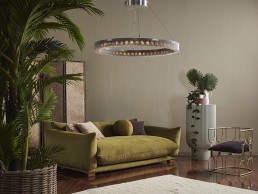Foscarini - Beep
Beep by Ludovica and Roberto Palomba for Foscarini is a wall sconce with a lot of intention behind its minimal appearance. The lamp rotates 360º allowing it to project and reflect light towards any direction desired.
An off-centre opening on the cap of the design helps deepen and diffuse light emitted, gracing its surroundings with an intimate and whimsical glow. Created with versatility in mind, Beep is optimal for the bathroom near a mirror, the living room hallway when grouped together, and many more application possibilities.
Home office lighting - Nulty's guide
Ellie Coombs, Managing Director, Nulty provides insight into lighting solutions for a home office.
“With many of us having found ourselves unexpectedly working from home, there’s been little time to consider our lighting set-up. But as we’re trying hard to settle into the rhythm of things, we’re starting to realise what does and doesn’t work in our hastily thrown together 'home office' arrangements. Whether it be a dedicated home office or makeshift-working environment, lighting can have a massive impact on our productivity, health and wellbeing – words we use a great deal, but which carry a lot more meaning at the moment.”
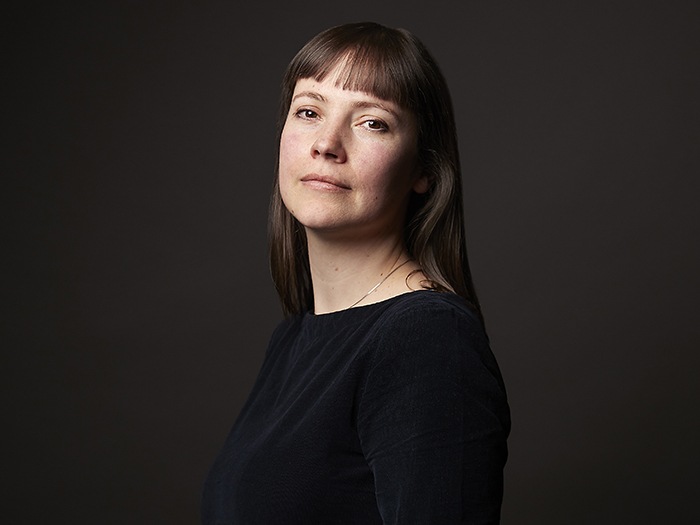
Daylight
“If you can, position your desk in front of a window – this will be, by far, the most positive thing you can do. Not only can daylight provide many benefits that artificial light can’t, the view out, however minimal, and connection to the outside world will help keep your spirits up. If you can’t actually sit by a window, then try and choose a space that has good access to daylight. If nothing else, this will help minimise the amount of artificial light you need (and keep down those rising electricity bills).”
Lighting for You
“Unfortunately, we don’t all have the luxury of a dedicated study in our homes; most of us are tucked into a makeshift space in the corner of our bedrooms, living rooms or even landings, and as such the overhead lighting is unlikely to be suitable. It will probably be positioned behind you and cast shadows on your work area. If it’s suspended, then you may struggle with glare and reflections on your computer screen and the light levels it provides may not be sufficient – especially if you’ve limited access to daylight or it’s an overcast day.
The simplest solution? A trusty task light. It doesn’t specifically need to be an office one; a bedside lamp will work, as long as it provides enough light. If you’re short on desk space, consider a wall or floor mounted light or one with a clip that you can attach to a shelf or piece of furniture (see Original BTC’s range of clip-on lights). If you’re short on plug sockets, try one with a USB connection that will run off your computer (see the Anglepoise 90 Mini Mini light). The added advantage of a task light is that it’s easy to move if you want to pack away your desk when you’re not working… because let’s not forget, it’s important to reclaim your home when you’ve finished working for the day. Whatever you use, take a bit of time to get it positioned correctly so that it casts a uniform light across your work surface and doesn’t create any discomfort or glare.”
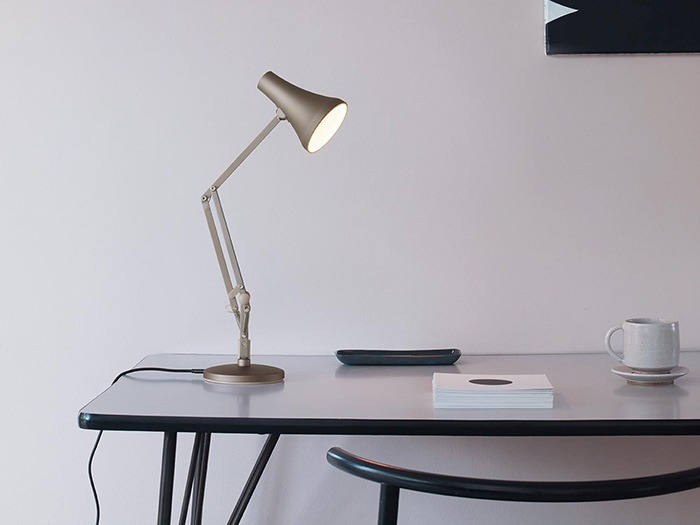
Lighting for Others
“There are a surprising number of things you need to consider when doing video conferences from home. Lighting can really impact how clearly you can communicate in a VC meeting, because a bad lighting set-up can cause a lot of visual distraction. So, how do you achieve a good lighting set-up? It’s all about balancing the layers of light…
Avoid having a window or direct view of a light source behind you, as the contrast will be too much for the camera to handle. Try and choose a backdrop that’s light in colour and introduce some general soft ambient light onto it – this is where the overhead lighting in the room will be of help. Now you have the backdrop sorted, you need to think about the foreground. Try to avoid lighting yourself from above or below as it’s unflattering.
If you’re facing a window, then the daylight should render your face perfectly – if not then that trusty task light can be adjusted to light your face. To get the best effect, you ideally want two light sources (one of which can be your task light), positioned either side of your screen – this will help to minimise unsightly shadowing.
If you think you look a bit washed out, you may need to change the lamp for one with a higher Colour Rendering Index, for example >CRI80. CRI is the ability of a light source to show the true colour of an object, or person in this case – the higher the number the better the colour rendering. Also, try and make sure all of the light sources you’re using have the same colour temperature (this is how warm or cool a light source appears – the lower the number the warmer the light) for consistency – typically residential lighting uses a warm light at around 2700K, while office lighting is generally a bit cooler at around 3000-4000K.
And lastly, take some time to play around with the lights you have to find the right combination and position. If you’re adjusting your task light, then consider using a bit of tape to mark the position so you can quickly and easily switch positions when someone calls you.”
Notes from a really small island
Covid-19 - what can we can learn from the SARS epidemic.
"Eighteen years ago a much younger version of myself moved to China in order to do business and source product for our brand and bigger clients like Tom Dixon and John Lewis. Arriving in Hong Kong mid-December 2002 I was amazed at the vibrant city I would soon be living in. I went first to the city of Guangzhou to join my girlfriend who was living there and working as a sourcing agent, a decisions that was to make me one of the first people in the world to witness the effects of coronavirus.
We were going to spend Christmas relaxing and take a trip to walk remote sections of the Great Wall. We never made that trip as two days later I was in a Chinese hospital on a drip recovering from a bout of food poisoning from a hot pot restaurant. Chinese healthcare was very good even then but I just hope they have started to make the surgical gowns in larger sizes! I was kept in for 48 hours on a drip and then released, the doctors seemingly bemused and amused at the weakness of my western gut!
On my way down to the admin office to pay my bill, incredibly a mere 78 quid, I passed several patients on trollies - covered in air bubbles to stop infection spreading - being pushed along by orderlies in full protective gear including breathing apparatus. If I remember correctly there were three of them in a line. It registered as serious and sent a shudder down my spine. As I crossed the big courtyard of the hospital I saw queues of people being triaged outside under Banyan trees by staff wearing paper overalls, masks and goggles.
I paid and saw an exit on the opposite side of the courtyard and went to try and get a taxi. Many taxis went past and none would stop, so I called a friend to pick me up who laughed heartily on arrival and told me that I would never get a taxi standing next to a sign that read in Chinese ‘Venereal Disease Unit’.
What I had seen in the hospital didn’t sink in until about four weeks later when, as people were dying in hospitals in Hong Kong from SARS, they traced the cause of the epidemic to Civet cats being eaten in restaurants in Guangzhou. Then I knew how close I’d been to the start of the epidemic that gave us all our first knowledge of the coronavirus - SARS had arrived.
The hospital I had been to was hit hard and many patients and wonderful dedicated medical staff died before they brought it under control. I never knew colonial or post colonial HK, my Hong Kong was ‘post SARS’ and we all quickly learnt how to deal with it and then how to design for it.
Culturally during the epidemic I was impressed with my fellow city dwellers as to how well they coped. Huge cleaning regimes, plastic covered lift buttons (although we all used our keys anyway), signs posted everywhere stating how frequently surfaces were disinfected.
Everyone quickly started wearing masks and the news came from Japan that researchers had discovered why it hadn’t effected Japanese cities as it had Hong Kong and other cities of the Pearl River Delta. The Japanese washed their hands more frequently and to a higher standard than the rest of us; it seems they are good at pretty much everything.
I remember being in a bar in Hong Kong and back then you could still smoke in public. I had seen a couple sitting at the bar sipping drinks through straws that were plumbed under their masks. As the man made his excuses to take a phone call out of the noisy bar his companion pushed down her mask and was inhaling a cigarette in seconds. I don’t think I’ve ever seen someone smoke a cigarette that fast. By the time he came back she had finished it and was sitting with her mask back on.
Masks became not just necessary but ‘cool’ and there were many designs quickly available. Luxury goods makers started making their own, fashion designers did special editions, with green quickly out of vogue in favour of black. Never again did I go to the doctor when I had flu or a cold without putting on a surgical mask. If you are sniffing you cover up; simple really to cap the source. We used to buy packs of five masks from 7 eleven for about a pound.
The first social change workplaces took on without any legislation being made was an acceptance that if you had flu like symptoms you stayed at home and went to the doctor. We had grown to a staff of eight and it was common and accepted for people to call quite last minute with a decision to work at home as they had a fever or flu symptoms. I’m not aware that we dropped any productivity due to this policy and neither did I ever see any evidence of abuse of it.
The really big changes came once the virus had been beaten and the hospitals emptied. Architecture got its moment in the spotlight, as part of the outbreak centred on a development in Hong Kong where many residents died. After analysis of the building services changes were made to standards. The close living of modern cities is great but we needed to learn lessons and implement them. Most buildings were fine but the authorities learned where weaknesses might be and strengthened everything. In fact the problem turned out not to be design but maintenance methods.
Then SARS slowly and quite subtley changed design. Small requests from designers and contractors, design ideas for public spaces that seemed odd until you thought about them in terms of a customer base of new and very militant germophobes.
Over the coming years I stayed in Hong Kong and watched as society took on SARS and made life normal again but with safety built in to prevent disease spread.
As the years progressed we saw a greater number of contract requests and design decisions taking hygiene into account. Clients passed their worries onto designers who quite rightly responded with change. Smooth surfaces were in, sealed edges etc and fabric choices changed to reflect worries over the germs they could collect. We began to work out proper instructions for cleaning products and not just paying lip service to the idea as we had years earlier when we were seldom asked about cleaning methods.
It is common now to see cleaning and hygiene mentioned in advertisements for serviced apartments and this can be very detailed with frequency and even methods listed.
Economically things took time to come back but the slower sectors were things like exhibitions and air travel. They did come back but if I had to make any forecasts for post Covid-19 it would be that with improved digital marketing and video connectivity the exhibitions and air travel industries could take even longer to recover - we will find new ways to market and display products.
The World Health Organisation (WHO) took note of the crisis and Dr Margaret Chan, who was senior health advisor to the Hong Kong Government, became famous during the outbreak and was promoted to head the WHO two years later. She was widely viewed as having handled the epidemic very well and took the knowledge with her to the WHO.
There were enquiries and recommendations of course but more than anything there was a thoughtful shift to other ways of doing things that would help stop it happening again. We humans are very good at adapting and figuring out threats.
For now, it’s about saving lives and taking this opportunity to get out there and do some good. I know neighbours I didn’t a month ago and now I do their shopping and run errands for them. We stand metres apart as I deliver things and they tell me stories and their news. Doing this feels as good as the launch of any product I’ve designed, or deal we have ever won.
If there are to be positives, it will be that the changes we make won’t just help us with the threat of Covid-19 but will help stop other diseases as well. The changes we make in terms of travel and work were coming anyway as we were - or should have been - doing them to stop climate change. Many of the things now required of us are sensible changes that will help this.
Afterwards many will try to go back to normal but this is a time to accept and respond to change and it can be a golden age where design and architecture can really do even greater good than before. Design will be socially relevant once more as well as culturally important.
**
Steve Jones studied Industrial Design at Newcastle Polytechnic (now University of Northumbria) from 1988-1992 before starting a career in consultancy in London. He has always advocated diversity as a way to stay on top in design and his own experience has seen him design things as diverse as ladies shoes, books, toys, even an internship in the naval architecture department of Swan Hunter shipbuilders. Later he worked extensively in the furniture industry before moving into lighting and forming Innermost with Russell Cameron in 1999.
Juniper - Ground Control Double USB-C Port
Lighting design and manufacturing studio, Juniper, is expanding their furniture-mounted power accessory collection with The Ground Control Double USB-C Port. The Ground Control Collection offers power and dimming accessories inspired by the dials and switches of mid-century mission control centres.
Using vintage aesthetics and modern functionality, Juniper constructs the Ground Control Collection in solid brass, providing people with a high-end experience whilst controlling and powering the latest technology.
The Ground Control Double USB-C Charger is Juniper’s
solution to universal charging capabilities. USB-C is for rapid charging, data,
audio and video transferring on new devices. New PCs and phones are switching
to USB-C parts for efficiency and universality, prompting Juniper to add the
option to their Ground Control Collection.
The Ground Control USB-C can be installed on desks, panels and furniture to create luxury charging stations for home, office and hospitality settings.
The power accessory features two USB-C parts and can pair with other Ground Control units like the Dimmer Dial and Power Receptacle for a custom tabletop system of lighting controls and power accessories.
West Rose, USA
Juniper, the Brooklyn-born lighting design and manufacturing studio features in West Rose, a newly-opened restaurant in Ellicottville New York.
The Thin Suspension Light has been chosen to accompany three unique bars at West Rose, highlighting the restaurant’s dedication to sophistication and simplicity. Designed in collaboration with Peter Bristol, the Thin modular lighting system is the essence of the minimalist architectural lighting, utilising slender LED arrays connected by magnetic end-caps to create made-to-fit, linear fixtures.
Co-owned by executive chef Brad Rowell, designer Caryn Dujanovich, and chef Anthony Petricelli, West Rose aims to provide ‘a gathering place for all’ through delicious, affordable, and seasonally inspired dishes. In collaboration with West End Interiors, Dujanovich brings warmth and sophistication to the minimal, airy design through repetition of shapes and textures.
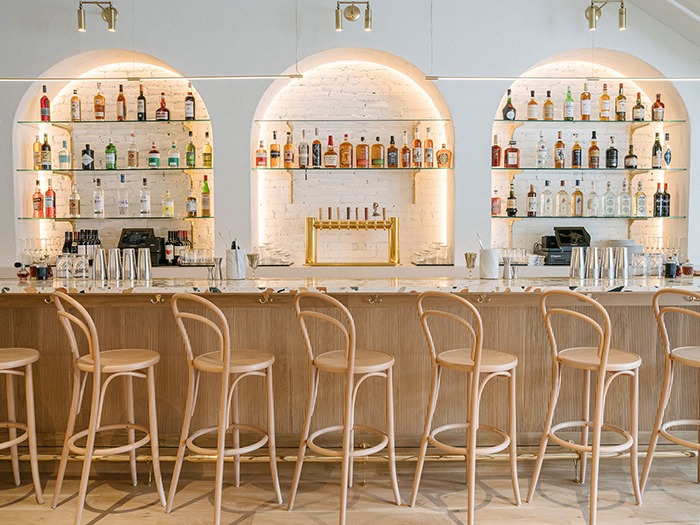
The Thin suspension light hovers delicately over the main, terrazzo-topped bar, illuminating a space made for comfort and connection. Hand machined in solid brass, the finish of the Thin suspension matches details in the restaurant, including a brass beer tap, overhead spotlights and the bar baseboard.
Juniper's Thin modular lighting system is the perfect choice to complement this old-moots-new-world aesthetic, Available in 24 or 36-inch segments, Thin can be modified to meet a variety of length and shape needs. Whether hovering delicately over a long bar, running vertically beside a vanity, or hanging as a one-of-a-kind statement piece, the versatility of Thin allows designers a chance to incorporate lighting that is tailor-made for their space.
Louis Poulsen reintroduces AJ Collection
(Denmark) - Louis Poulsen brings back AJ table mini and AJ Royal to celebrate 60th anniversary of SAS Royal Hotel in Copenhagen.
All the versions of the AJ Lamp are also being re-launched in stainless steel, which reflects their surroundings in the spirit of Arne Jacobsen and emphasises the distinctive shape design, as well as impeccable illumination.
There will be three new special edition colours that are only available in 2020: Original Grey, Pale Rose and Ultra Blue.
Arne Jacobsen designed the AJ Lamp for the SAS Royal Hotel in
1957. Today, the series is regarded as the design that the Danish architect is
best known for all over the world. In combination with the pendant AJ Royal,
the AJ Lamp formed part of the overall design concept that Jacobsen created for
the hotel.
The AJ Lamp was used in several parts of the hotel, in copper
and stainless steel. The AJ Royal, which at the time was simply called the AJ
Pendant, could be found in a copper version above the tables in the snack bar
behind the atrium, in the lounge on the 1st floor and in the Panorama
lounge on the 21st floor. The hotel opened in 1960 and with 22
floors it gave Copenhagen it first real high-rise building, clearly inspired by
New York skyscrapers.
The AJ Royal is available in white, in its two original sizes. A new, smaller version will be introduced in 2020 as well, just as the series will be reintroduced in black. The AJ Royal retains its classic, graphic look as sharply as ever. The lamp can be used to light up a dining table, used in an office, or a showroom, where it ensures even and flawless downward lighting and generates an ambience in any space with its muted upward light. In the new, energy-saving LED version all three sizes of pendants come with a diffusor that offers smoother glare-free lighting.
The AJ Table Mini will be available in the original version in stainless steel, and in all existing colours. The new AJ versions will be available in stores from Spring 2020.
Covid-19 impact on design industry
(Global) – US design shows latest to cancel amid coronavirus concerns.
The ongoing coronavirus pandemic continues to see design events and trade shows around the world forced to reschedule or cancel completely, with a series of US-based shows due to take place in May the latest casualties.
It was announced earlier in the month that HD Expo, Las Vegas, ICFF and Wanted Design in New York have all now been cancelled for 2020, with Lightfair organisers confirming they will push the event back to “late summer or early autumn.” Currently, *Cruise Ship Interiors Expo in Miami and Lightovation in Texas, both planned for June, are scheduled to take place as planned, however NeoCon in Chicago – also set for June – has been ‘suspended’ with new dates yet to be confirmed.
In the UK, May’s Clerkenwell Design Week has – for now at least - been pushed back to 14 – 16 July; while Design Shanghai Fair has confirmed the show will now be held from 26 - 29 May.
During these uncertain times, darc magazine wants to support the decorative lighting industry as best we can. Many of you will have planned to launch new product lines at the shows mentioned and as such, instead of our usual Show Product Previews, we are introducing a more general Product Focus feature for the May/June issue – highlighting products launched so far this year and those that were due to launch at cancelled shows and events.
We are also planning a series of dedicated product newsletters over the coming months - focusing on recent launches and we welcome you to submit your latest offerings for inclusion. The magazine is still being posted out to our global circulation of 12,000 industry professionals – many of whom will be limiting their social interaction and in need of something to read!
Now more than ever, it is important we work together to ensure the industry survives. For up-to-date information on show cancellations and new dates, bookmark this article and refer to the events list below. You can also refer to our online Events Diary, which will be updated regularly.
*Numerous show amendments have been made since this post was published. Please refer to the information below for the latest updates.
2020 Design Events
March
light+building • frankfurt, germany • 8 - 13 march • new dates: 13 - 18 March 2022
April
salone del mobile • milan, italy • 21 - 26 april • new dates: 13 - 18 April 2021
archiproducts • milan, italy • 21 - 26 april • new dates: 13 - 18 April 2021
retail expo • london, uk • 29 – 30 april
May
hd expo • las vegas, usa • 5 - 7 may • new dates: 4 - 6 May 2021
icff • new york, usa • 17 – 20 may • new dates tbc 2021
wanted design • new york, usa • 17 - 20 may • new dates tbc 2021
clerkenwell design week • london, uk • 19 - 21 may • new dates: 25 - 27 may 2021
June
cruise ship interiors expo • miami, usa • 16 - 17 june • new dates: 8-9 June 2021
lightovation • dallas, usa • 24 - 27 june • cancelled
September
maison & objet • paris, france • 4 – 8 september
london design festival • london, uk • 12 - 20 september
index • dubai, uae • 14 - 16 september
london design fair • london, uk • 17 - 20 september • new dates tbc 2021
[d]arc room @ london design fair • london, uk • 17 – 19 september • new dates tbc 2021
October
decorex • london, uk • 11 - 14 october
index • doha, qatar • 13 - 15 october
hong kong light fair • hong kong • 27 - 30 october
November
bdny • new york, usa • 8 - 9 november
sleep and eat • london, uk • 17 - 18 november
hix • london, uk • 19 - 20 november
December
[d]arc awards • london, uk • 3 december
cruise ship interiors expo • london, uk • 2 - 3 december
Clerkenwell Design Week postponed
(UK) - In light of the global impact caused by COVID-19 and following careful consideration, Clerkenwell Design Week will now take place 14 - 16 July 2020.
In a statement the organisers have said that, as one of the UK’s leading independent design festivals, this decision has not been taken lightly, but the health, safety and wellbeing of the show's visitors, exhibitors, clients and staff is its number one priority.
Agreement has been reached, following productive discussions with Islington Council, to ensure that the new date will deliver the much-loved festival without compromise. All of the show's suppliers, venues and stakeholders have collaborated to agree this new date and to ensure that the event goes ahead.
“We will continue to consult with all relevant parties on a regular basis as we work towards delivering the best possible CDW this summer," says Lee Newton, CEO, Media 10. "The safety and wellbeing of all those involved is our priority and we are grateful for the support we have received from our exhibitors and partners in making this difficult decision. We believe that these new dates provide us with an opportunity to deliver what will be a very successful CDW in the height of British Summer.”
Menu - Hashira Collection
Menu launches the Hashira Collection, a modern, Nordic take on the traditional Japanese rice paper lantern. A fusion of East and West, Hashira is a new collection of floor, table and pendant lamps for modern spaces. Designed by Norm Architects, the collection takes its cues from visits to traditional Japanese Washi papermakers and its name from the Japanese word for column or pillar.
The cylindrical Hashira floor Lamp rises from the floor. The translucent fabric shade not only acts as a diffuser, projecting the light in multiple directions while creating a cosy, glare-free ambience, it also adds appeal that enhances the softness of an interior. Shaped from the basic geometric form in architecture, the slender Hashira table lamp is set on a wooden base that underpins the minimalist expression and is visible through the translucent fabric shade that softly diffuses the light in multiple directions.
The Hashira Cluster, a trio of pendants suspended from a black textile cord, is in two sizes (small and large) and the collection’s single pendant light, available in two sizes, is created with the same column-like shape as the floor and table lamps to fill spaces with cosy, ambient light.
Menu - Reverse Lamp
Menu presents Reverse Lamp, a new lighting solution that underpins the ever-present beauty of natural materials. Danish designer Aleksandar Lazic looked to Italian marble tables from the 1970s when creating the new piece.
Inspired by the play on structure created by geometric constraints, the conical travertine base and curved, bronzed aluminium shade define the lamp’s expression. The light diffuses evenly across the unworked stone to allow the light to highlight its natural imperfections, revealing shadows and an intriguing colour play that seems to stem from the base itself. At precisely the point at which the shade and base meet sits a dimmer switch for adjusting the light intensity.
Fitted with a dim-to-warm LED light source, the Reverse Lamp casts warm light on a bedside table or subdued light on a cabinet surface, making it an elegant and characterful solution to a multitude of lighting needs.
willowlamp releases new designs
(South Africa) - The start of a new decade has brought with it a collection of new designs from renowned South African lighting company willowlamp.
The Radial is one of the new pieces making its design debut this year. In the spirit of evolution, founder and creative director Adam Hoets has built on some of his existing designs with new interpretations stemming from these existing pieces.
“The Radial is a logical extension of the Lineal – essentially a round version of this piece,” says Hoets. “The inspiration behind the Radial hails from a similar source to the Lineal, which comes from the idea of creating a textured grid around a repetitive matrix of lights, and adding chain in layers and in different metallic finishes to add a richness and warm glow. Like virtually all of willowlamp’s pieces, The Radial also draws on the natural world. ‘The Radial refers to the eternal, cyclic ring of life.”
The popularity of curvaceous shapes in contemporary lighting design is what prompted Hoets to create something along similar lines to add to the willowlamp range. And while Hoets is never one to follow or be guided by ‘trends’, preferring instead to create timeless pieces and innovate in unique directions, he felt the urge to play with current typology in his own way.
“Ring lights are fairly ubiquitous at the moment and the Radial is a kind of response to this popular style. I almost called the design the One Ring after the ‘one ring to rule them all’ in Lord of the Rings, because I hope I’ve created a particularly beautiful version of this form,”
This design has the advantage of being both decorative and understated at the same time, filling a perfect gap for homeowners who want something glamorous but minimal for a contemporary space. Additionally it can be a very powerful light source, courtesy of 56 LEDs.
You can decide on the intensity of light and adjust its strength by using different bulbs – 1W (for purely decorative) or 2W each (a total of 112W). This gives it great versatility and allows it to serve as a stylish piece in a work environment, or take pride of place in a home or hospitality setting.
“The slender profile makes it really easy to place – a great option for spaces with low ceiling volumes, which seems to be quite common these days. So, it’s a great way to have an amazing light with potentially loads of power, even in a low space.”
willowlamp - The Radial
The start of a new decade has brought with it a collection of new designs from renowned South African lighting company willowlamp.
The Radial is one of the new pieces making its design debut this year. In the spirit of evolution, founder and creative director Adam Hoets has built on some of his existing designs with new interpretations stemming from these existing pieces.
“The Radial is a logical extension of the Lineal – essentially a round version of this piece,” says Hoets, “The inspiration behind the Radial hails from a similar source to the Lineal – which comes from the idea of creating a textured grid around a repetitive matrix of lights, and adding chain in layers and in different metallic finishes to add a richness and warm glow. Like virtually all of willowlamp’s pieces, The Radial also draws on the natural world. ‘The Radial refers to the eternal, cyclic ring of life.”
The popularity of curvaceous shapes in contemporary lighting design is what prompted Hoets to create something along similar lines to add to the willowlamp range. And while Hoets is never one to follow or be guided by ‘trends’, preferring instead to create timeless pieces and innovate in unique directions, he felt the urge to play with current typology in his own way.
“Ring lights are fairly ubiquitous at the moment and the Radial is a kind of response to this popular style. I almost called the design the One Ring after the ‘one ring to rule them all’ in Lord of the Rings, because I hope I’ve created a particularly beautiful version of this form,”
This design has the advantage of being both decorative and understated at the same time, filling a perfect gap for homeowners who want something glamorous but minimal for a contemporary space. Additionally it can be a very powerful light source, courtesy of 56 LEDs.
You can decide on the intensity of light and adjust its strength by using different bulbs - 1W (for purely decorative) or 2W each (a total of 112W). This gives it great versatility and allows it to serve as a stylish piece in a work environment, or take pride of place in a home or hospitality setting.
“The slender profile makes it really easy to place – a great option for spaces with low ceiling volumes, which seems to be quite common these days. So, it’s a great way to have an amazing light with potentially loads of power, even in a low space.”


